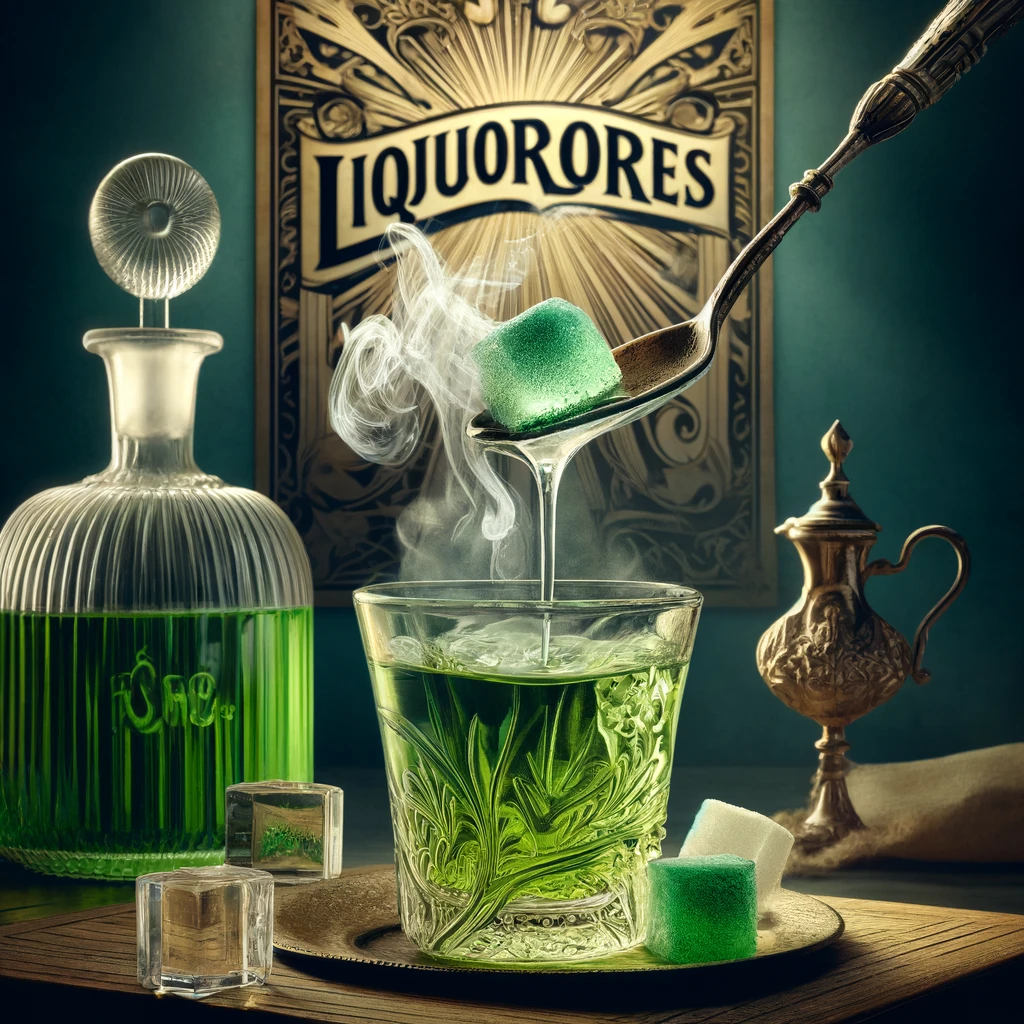
Table of Contents
Absinthe, often referred to as the “Green Fairy,” has captivated the imaginations of artists, writers, and aficionados worldwide with its enigmatic allure and storied past. This potent spirit, distinguished by its vibrant green hue and complex flavor, has experienced a remarkable revival in recent years, finding a new place in modern bars and homes. Let’s explore the fascinating journey of absinthe from its origins, through the swirling myths surrounding its effects, to its resurgence in contemporary culture.
Origins of Absinthe
The origins of absinthe can be traced back to the late 18th century in the Val-de-Travers region of Switzerland, where it was initially developed as an elixir. However, it wasn’t until it crossed into France that absinthe began to gain fame. In the 19th century, French soldiers consumed absinthe as a malaria preventative during the colonial wars. Upon returning to France, their continued affection for the “Green Fairy” propelled its popularity among the masses.
By the 1850s, absinthe had become a staple in French cafes and bistros, celebrated during the famed “l’heure verte” (the green hour), an early evening period where people would indulge in a glass or two of absinthe. It wasn’t just the general populace that embraced absinthe; the spirit was a favorite among many artists and writers, who believed it stimulated creativity. Famous personalities like Vincent van Gogh, Oscar Wilde, and Ernest Hemingway sung its praises and featured it in their works.

Origins of absinthe in a 19th-century French cafe during “l’heure verte” (the green hour), capturing the lively and artistically inspired atmosphere.
Myths and Misconceptions
The allure of absinthe is partly due to the myths that surround it. One of the most enduring legends is that absinthe induces hallucinations and other psychoactive effects. This reputation is largely due to thujone, a compound found in wormwood—one of absinthe’s key ingredients. Historical absinthes did contain higher levels of thujone than those produced today, but contemporary research suggests that the psychoactive effects were likely exaggerated. Additionally, absinthe is a highly potent alcohol, typically ranging from 45% to 74% alcohol by volume, contributing to its reputation and effects.
The misconceptions about absinthe’s effects led to its ban in the United States and many European countries in the early 20th century. The bans were also fueled by the temperance movement and the wine industry, which saw absinthe as a threat to their economic interests. It wasn’t until the late 20th and early 21st centuries that these bans began to be lifted, following rigorous campaigns by absinthe enthusiasts and distillers to prove its safety.
Proper Way to Drink Absinthe
Enjoying absinthe is an art form in itself, often involving a traditional preparation method known as the French Method. To properly drink absinthe, you need an absinthe spoon, a sugar cube, and a carafe of ice-cold water. Place the spoon over a glass containing a shot of absinthe, and put the sugar cube on the spoon. Slowly drip water over the sugar cube, which dissolves into the absinthe, creating a cloudy effect known as “louching.” This ritual not only enhances the flavor but also the overall experience of drinking absinthe.
Additionally, Absinthe can be a unique and flavorful addition to cocktails, providing an herbal complexity that enhances the depth of the drink. Popular in concoctions like the Sazerac and the Corpse Reviver #2, absinthe adds a distinctive anise flavor that pairs well with a variety of spirits and mixers. Its potent profile means that a small amount can significantly influence the overall taste of a cocktail, making it a favorite among mixologists seeking to create bold, aromatic drinks.
Culinary Pairings with Absinthe
When it comes to pairing food with absinthe, choose dishes that complement its robust profile. Traditional French appetizers like olives, cheese, and charcuterie balance the bitterness and complexity of absinthe. For a more modern approach, try seafood dishes or even dark chocolate, which can soften the spirit’s intensity and bring out its herbal notes.
Bans and Legalization
The banning of absinthe in the early 20th century across many countries stemmed from its association with violent crimes and social disorder, purportedly driven by its psychoactive effects. These bans reflected a broader cultural backlash against what was seen as a symbol of decadence and moral decline. Over time, as misconceptions were cleared and absinthe’s mystique continued to grow, countries began to lift their bans. Today, absinthe is once again legal in most parts of the world, enjoyed by those who appreciate its unique history and complex flavor.
The story of absinthe is one of mystery, prohibition, and revival. From its early days as a medicinal tonic to its role in the bohemian lifestyles of the 19th-century Parisian artists, and its recent resurgence in bars and homes around the world, absinthe continues to fascinate and inspire. Whether you are drawn to its history, intrigued by its myths, or simply enjoy its complex flavor, the Renaissance of absinthe offers something for everyone. As we enjoy this storied spirit today, we connect with a rich tapestry of history that adds depth and color to our modern drinking experiences.
Absinthe World-Wide Today
In the United States, absinthe was banned in 1912 but was made legal again in 2007. The absinthe sold in the U.S. must comply with regulations that limit the thujone content—thujone being the chemical compound that was historically blamed for absinthe’s reputed psychoactive effects. Modern absinthe in the U.S. must contain less than 10 parts per million of thujone.
In India, there is no specific ban on absinthe. Absinthe in India might be less common in everyday bars and liquor stores compared to other spirits like whisky and rum, but it can be found in larger cities or specialty stores.
In Europe, absinthe is legal and widely available in many countries, particularly in those with a strong historical connection to the drink, such as France, Switzerland, and the Czech Republic. The European Union has regulations that govern the production and sale of absinthe, which include limiting thujone content to 35 milligrams per kilogram in the finished product.
France, once the heart of absinthe culture, lifted its ban on the spirit in 1988, although with regulations that continued to control the use of the term “absinthe” until even more recent times. Now, traditional absinthe can be legally produced and sold there. Switzerland, where absinthe originated, lifted its long-standing ban in 2005 and now celebrates absinthe as a part of its cultural heritage.
In the Czech Republic, absinthe has been continuously available and was never banned. The country is known for a unique style of absinthe as well as for the traditional “Czech method” of absinthe preparation, which involves setting the sugar cube on fire.
Overall, absinthe enjoys a resurgence across Europe with an emphasis on artisanal and traditional production methods, adhering to historical recipes and quality standards.
The story of absinthe is one of mystery, prohibition, and revival. From its early days as a medicinal tonic to its role in the bohemian lifestyles of the 19th-century Parisian artists, and its recent resurgence in bars and homes around the world, absinthe continues to fascinate and inspire. Whether you are drawn to its history, intrigued by its myths, or simply enjoy its complex flavor, the Renaissance of absinthe offers something for everyone. As we enjoy this storied spirit today, we connect with a rich tapestry of history that adds depth and color to our modern drinking experiences.
How useful was this post?
Click on a star to rate it!
Average rating 5 / 5. Vote count: 1
No votes so far! Be the first to rate this post.
